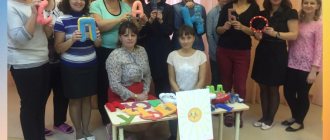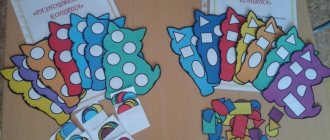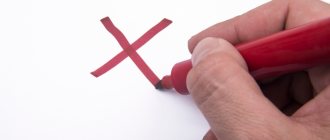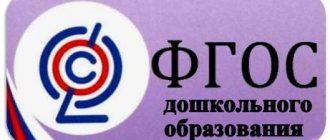Features of interaction between a speech therapist and educator in modern conditions of a preschool educational institution
Features of interaction between a speech therapist and educator in modern conditions of a preschool educational institution.
Abstract: Organization of comprehensive correctional work to overcome speech disorders in children with the participation of specialists of various profiles is an urgent task. Its successful solution is possible only if there is unity of requirements imposed by the educator and the speech therapist. Taking this into account, the creation of a system of interaction between preschool education specialists deserves special attention.
A distinctive feature of the educational process with children with speech disorders is that in addition to teaching, development, and educational tasks, the teacher also faces correctional tasks. The teacher is actively involved in eliminating speech defects in preschoolers. Therefore, the choice of methods and means of interaction with pupils of this category is important in their training and education.
The formation of correct speech is of great importance for the development of a child’s full personality. The preschooler’s consistent mastery of all components of speech without accelerating this process will in the future become the key to his successful learning at school. At the same time, the effectiveness of work on the development of children’s speech directly depends on the ability of the speech therapist and educator to plan it competently.
Taking this into account, the creation of a system of interaction between preschool education specialists deserves special attention. The process of interaction in the conditions of a modern preschool educational institution must be fine-tuned both in form (the presence of a partnership, understanding of the interests and professional tasks of the parties) and in content (the creation of joint programs to optimize the development of children).
When developing the content of activities in this direction, it was taken into account that the interaction process should be based on the principles of partnership, dialogism, as well as complementarity and continuity. Therefore, during the school year, meetings were held during which educators and the speech therapist teacher exchanged opinions on the forms and content of joint work and the process of preparing children for school.
At the beginning of the school year, the speech therapist teacher introduces the results of the examination of children, as well as the program of correctional work for the school year, explains the goals, objectives and methods of implementing the program, determines the timing and duration of its implementation, and conducts a joint discussion of ways to implement the assigned rehabilitation tasks children with speech disorders. When determining the content of correctional and developmental work, a long-term plan is discussed, and the most rational methods for carrying out speech correction for each child are specified.
Target:
- building a unified system of interaction between a speech therapist and preschool educators
Tasks:
- Develop unified (variable) approaches to the interaction between a speech therapist and a preschool teacher.
- Select new effective and exchange existing forms of interaction in a specialized preschool educational institution.
- To delimit the areas of responsibility of the speech therapist and preschool teachers in correctional and developmental work.
- Select software for interaction between a speech therapist and teacher using ICT.
Work plan:
Interaction between a speech therapist and educators during diagnosis, determination of volumes and spheres of influence, forms of cooperation.
Interaction between a speech therapist and educators during correctional and developmental activities, forms of cooperation.
Functionality of a speech therapist and educators.
Building interaction using information and computer technologies.
Planned result: selection and development of unified (variable) approaches to the interaction between a speech therapist and preschool teachers.
The coordinated work of a speech therapist and educators is based on the following principles:
- The principle of an integrated approach to the organization of the correctional pedagogical process.
- The principle of unity of diagnosis and direct correctional pedagogical process
- The principle of cooperation between the speech therapist teacher, educators and children
- The principle of taking into account the interests of all participants in the correctional pedagogical process.
- The principle of a differentiated approach to logopaths in the process of educating them to correct speech.
For ease of use, we have developed:
- Long-term plan for interaction with specialists.
- Notebooks for interaction with teachers of compensatory groups for organizing correctional and developmental work in the afternoon.
- A sound screen that displays the stages of work on speech sounds for each child.
Joint correctional work in a speech group involves solving the following tasks:
- Speech therapist forms primary speech skills in children-speech therapists
- The teacher consolidates the formed speech skills
Main types of organization of joint activities of a speech therapist and teacher
1. Joint study of the content of the training and education program in a special preschool institution and drawing up a joint work plan.
2. Joint planning of the teacher’s classes, ensuring the necessary consolidation of the material in various types of children’s activities.
3. Discussion of the results of joint study of children, which was conducted in the classroom and in everyday life.
4. Joint preparation for all children's holidays (the speech therapist selects speech material, and the teacher consolidates it).
5. Development of general recommendations for parents.
A speech therapist teacher must not only teach educators how to work with each child, but also monitor the implementation of his recommendations. The relationship notebook, where the speech therapist teacher enters his assignments, is filled out once a week.
The content of the work is revealed in three sections:
1. Five-minute speech therapy sessions.
2. Games and exercises.
3. Corrective and developmental activities in an individual form.
Speech therapy five-minute sessions can be used by teachers in different situations and other activities. Five minutes should be short enough, they should not be turned into a long process. They should be carried out in a playful and entertaining way against a good emotional background. Five-minute sessions should correspond to the lexical topic studied during the week and contribute to the development of all components of speech in children. The speech therapist teacher, in turn, must indicate the goals and objectives that are pursued when performing each task, and give a detailed description of them.
Games and exercises recommended by a speech therapist can be taught by teachers in the afternoon or used during dynamic breaks.
Corrective and developmental activities in an individual form are carried out by the teacher, both in the first and second half of the day. Every day, the teacher works with 2-3 children and conducts articulatory gymnastics, tasks on automation and differentiation of sounds, as well as tasks on those sections of the program that children learn with the greatest difficulty. Considering that teachers have card indexes of games, exercises for the development of visual and auditory attention (memory), fine motor skills, exercises for the development of coordination of speech with movement, and each card in the card index has its own number, the speech therapist only needs to indicate the card number. This makes it easier for the speech therapist to write daily assignments for educators.
A speech therapist teacher observes the work of a teacher with children, attending direct educational activities, noting positive aspects, and also analyzes those types of work that were unsuccessful and did not give the expected result. Such visits show the teacher-speech therapist a complete picture of correctional and developmental work, expands their understanding of correctional work, they master the techniques, methods, and teaching technologies that the specialist owns.
Only a close relationship in the work of a speech therapist and educators makes it possible to achieve positive results in correcting the speech of preschoolers.
Interaction between a speech therapist and a teacher using ICT
- Conducting finger games with children and breathing exercises using a computer by the teacher of the speech therapy group during scheduled moments and during the speech therapy hour in the afternoon, on the recommendation of the speech therapist
- the use of a certain video sequence (for example, picture material on lexical topics) for demonstration in complex classes conducted jointly by a teacher and a speech therapist of a speech therapy group, as well as for the teacher to reinforce educational material in his classes and during scheduled moments in the afternoon
- the use of various speech therapy games and exercises in individual lessons of the teacher on the instructions of the speech therapist.
Speech therapy classes using computer programs and technologies are conducted in compliance with SanPiNov standards:
- using new computer models
- working with a computer in one lesson for a short time (5-10 minutes) and no more than twice a week (individually, depending on the age of the child, his nervous system)
- Carrying out hygienic exercises for the eyes; while working, we periodically move the child’s gaze from the monitor every 1.5 - 2 minutes for a few seconds
- inclusion in speech therapy classes of games aimed at preventing visual impairment and developing visual-spatial relationships
At the end of the school year, final meetings between educators and the speech therapist are held, during which difficulties in organizing joint correctional and educational work are discussed, the effectiveness and prospects of activities are determined, and the dynamics of children’s development are assessed.
It should be noted that the interaction between teachers and speech therapists organized in this way made it possible to ensure positive dynamics in the speech development of children, which is one of the key indicators of children’s readiness for school.
Yaroshenko L.Yu., speech therapist
- Interaction between the music director, speech therapist and educator
- Plan of interaction between a speech therapist and participants in the correctional pedagogical process
- The relationship between the work of a speech therapist teacher and a teacher in a speech therapy group for children with special needs development disorders (from work experience)
- Self-analysis of the work of a teacher-speech therapist on the methodological topic: “Modern forms of interaction between teacher-speech therapist and family”
- The use of modern educational technologies in the practical activities of a preschool teacher-speech therapist
( 1 liked, average score: 5.00 out of 5)
Loading...
MAGAZINE Preschooler.RF
Interaction between a speech therapist and educator in working with children with general speech underdevelopmentMBDOU combined type No. 271 Teacher-speech therapist Saparova E.N. Teacher Dubova T.G.
General speech underdevelopment (GSD) in children with normal hearing and intact intelligence is a disorder that covers both the phonetic-phonemic and lexical-grammatical systems of the language.
An approach to the problem of overcoming general speech underdevelopment involves comprehensive planning and implementation of speech therapy work with these children.
Corrective and developmental work with children with special needs requires a clear organization of children’s stay in kindergarten, proper distribution of the load during the day, coordination and continuity in the work of the speech therapist and teacher.
T. B. Filicheva, T. V. Tumanova
Model of interaction between subjects of the correctional and educational process.
The coordinated work of the speech therapist and group educators is based on the following principles:
- the principle of an integrated approach to organizing the correctional pedagogical process
- the principle of unity of diagnosis and direct correctional pedagogical process
- the principle of cooperation between the speech therapist teacher, educators and children
- the principle of taking into account the interests of all participants in the correctional pedagogical process
- the principle of a differentiated approach to speech pathologists in the process of educating them to correct speech
Forms of collaboration
- joint comprehensive thematic planning
- exchange of information, discussion of children's achievements
- personal contacts, conversations
- consulting teachers on the results of diagnostic studies, consulting on personal difficulties (most often these are issues related to correction methods
- practical seminars, medical and pedagogical advice, open viewings of classes (mutual visits between speech therapist and teacher)
- joint preparation for all children's holidays, maintaining joint documentation (interaction notebooks)
- design of methodological piggy banks, memos, parent corner
- Functions of a speech therapist:
- formation of correct speech breathing;
- sound pronunciation correction;
- improving phonemic perception and sound analysis and synthesis skills;
- elimination of shortcomings of the syllabic structure of the word;
- formation of syllable reading;
- practicing new lexical and grammatical categories;
- teaching coherent speech;
- prevention of writing and speech disorders;
- development of mental functions.
Positive results are achieved through close cooperation between the speech therapist and educators.
Functions of the teacher:
- taking into account the lexical topic during all classes;
- replenishment, clarification and activation of the dictionary on a lexical topic in the process of regime moments;
- constant improvement of articulation and general motor skills;
- systematic control over the correctness of speech (sounds, grammar);
- formation of coherent speech;
- strengthening reading and writing skills;
- consolidation of speech skills in ind. classes on the instructions of a speech therapist;
- development of understanding of speech, memory, thinking in game exercises.
Directions of the teacher’s work during the day
- development of vocabulary (in the teacher’s classes on familiarization with the outside world, fiction, productive activities)
- development of grammatical structure (individual work on the instructions of a speech therapist);
- development of the phonemic system of the language (individual work on the instructions of a speech therapist, a notebook for joint work between teachers and a speech therapist);
- motor development
While dressing, the names of body parts, items of clothing, actions are repeated (put on, tie, tie, fasten)
When developing cultural and hygienic skills, we also clarify pronunciation and agreement of words
towel (soft, fluffy, multi-colored, terry, etc.);
soap (scented, aromatic, slippery, etc.);
During self-service
- the names of the bedding are repeated;
- what are they made of:
- pillow (soft, downy, warm);
- blanket (cotton, wool, warm, light, pleasant).
When organizing catering
- the names of the prepared dishes, what products the dish is made from, their taste (apple compote, pea soup, cottage cheese casserole, etc.).
While dressing for a walk
- establishes the name of outerwear, shoes and their seasonal purpose;
- color and variety of material from which clothing and shoes are made (fur, wool hat;
- boots, rubber, leather, felted, etc.).
Work on enriching the vocabulary is also carried out on walks
- excursions outside the kindergarten (hairdresser, shop, library);
- targeted walks (observations of transport, house construction, etc.);
- walks - hikes;
- observations (of living and inanimate nature, the work of adults).
During morning exercises and exercises after naps
- consolidation of temporary concepts (parts of the day, month and seasons, orientation in space);
- standards of color, shape, size;
- enriching vocabulary with quality adjectives, etc.;
When directing gaming activities
involving children in a dialogue where all speech development tasks are solved: ( “What will you play? Who will you be? What do you need for the game?” , What will you do?”);
( “Give me a car, please” ; “What kind of car” ; “Iron, truck, plastic, green...” , etc.);
During work
verbs with prefixes are practiced (collect, arrange, select, bring, wash, etc.);
spatial concepts are reinforced ( “put it on the box” , “put the car on the bottom shelf” );
the use of prepositions, etc. is reinforced.
While on duty
the name of various dishes is fixed;
the material from which it is made (plastic tray, ceramic plate);
planning activities with speech accompaniment during table setting.
Didactic games
- on the development of phonemic hearing,
- education of sound culture of speech,
- vocabulary enrichment,
- formation of grammatical structure of speech;
- development of coherent speech;
- literacy training and much more.
Physical education minutes
- formation of coherent speech;
- systematic control over the grammatical correctness of children’s speech;
- replenishment, clarification and activation of children’s vocabulary on the current lexical topic;
- improvement of fine and gross motor skills
Comparative results of indicators of speech development of children with SLD (2014-2015 academic year)
Successful overcoming of speech underdevelopment is possible provided:
- close relationship between the speech therapist and the teacher;
- unity of requirements for children;
- joint lexical and thematic planning of work;
- formation of a unified speech regime (correct speech of employees, creation of conditions for expanding the speech activity of children, creation of a correctional and developmental speech environment).
Thank you for your attention!
| Next > |
Consultation progress
- Introductory conversation.
One of the brightest trends in the modernization of education is the provision of state guarantees of accessibility and equal opportunities for children with disabilities to receive a full education. Thus, children with speech development disorders should receive timely and qualified correctional and speech therapy assistance in preschool settings. At the same time, the problem of finding effective ways to correct speech is becoming increasingly important.
Only with close cooperation and unity of the requirements of specialists is it possible to overcome the speech development disorders that children have. Collaboration between a speech therapist and preschool teachers plays a special role in the speech therapy group.
- Principles and features of organizing joint activities of a speech therapist teacher and a preschool educational institution logotype teacher.
The joint activities of a speech therapist and preschool educators are organized in accordance with the following goals:
- increasing the effectiveness of correctional and speech therapy work;
- rational distribution of speech therapist and educators’ activities during the day to avoid overloading children;
- adequate selection of forms, methods, techniques and means of correctional pedagogical activities of the speech therapist and educators, aimed at both the entire group of children and an individual child.
The main types of organization of joint activities of a speech therapist and educators:
- joint study of the content of preschool educational institutions programs and drawing up a joint work plan;
- open classes with a speech therapist teacher to familiarize educators with basic teaching techniques, the selection of visual and speech material, as well as the requirements for children’s speech;
- discussion of the results of joint work with children, which was carried out in and outside the classroom;
- joint preparation for children's parties;
- development of general recommendations for parents.
Functions of a speech therapist and educator in the development of speech components of preschool children and non-speech mental processes associated with speech
Table 1.
| Functions of a speech therapist | Functions of a teacher |
| Development of the phonetic component of the language system. | Improving speech breathing, articulation and fine manual motor skills of children. Constant control over the correct pronunciation of the given sounds. |
| Formation of phonemic processes. | Taking into account the lexical topic chosen by the speech therapist during all group classes during the week. |
| Improving the state of the lexical component of speech. | Incorporation of practiced grammatical structures into situations of natural communication in children. |
| Development of the word formation process of nouns, adjectives, verbs. | Formation of coherent speech. |
| Formation of the grammatical structure of speech. | Strengthening graphomotor skills. |
| Improving coherent speech. | Development of attention, memory, verbal-logical thinking, imagination in game exercises on defect-free speech material. |
| Improving graphomotor skills and introducing children to the basics of literacy. | |
| Development of non-speech mental functions closely related to speech: verbal-logical thinking, memory, attention, imagination. |
Educators carry out the tasks of the speech therapist every day, using individual, subgroup and frontal forms of work, as well as routine moments.
Educators should know:
- main directions of the correctional program;
- age-related and individual characteristics of speech formation in preschoolers;
- features of the pronunciation and lexico-grammatical aspects of speech and take into account the speech capabilities of each child in the process of educational and extracurricular activities.
Educators must comply with the conditions for the development of speech activity and verbal communication of children:
- organize and support children’s verbal communication in class and outside of class;
- encourage you to listen carefully to other children;
- develop skills of self-control and critical attitude to speech;
- organize games to develop the sound culture of speech;
- carry out work on the development of auditory and speech attention.
Speech therapy group teachers should not:
- rush the child to answer;
- interrupt speech and rudely pull it back, but should tactfully give an example of correct speech;
- force the child to pronounce a phrase rich in sounds he has not yet identified;
- let memorize texts and poems that the child cannot yet pronounce.
It is recommended to allocate a place in the group for speech therapy classes, the so-called speech therapy corner, in which there should be board-printed games for the formation of the correct air flow, the development of non-speech processes, in the joint activity of an adult with children, in the free independent activity of children.
The speech therapist, together with preschool teachers, designs the parent corner, prepares and conducts parent meetings.
- Conclusion.
Correct, pedagogically justified interaction between educators and a speech therapist, combining their efforts in the interests of speech correction in children, is based on the creation of a friendly, emotionally positive environment in a speech therapy group.
Speech development is decisive in the level of human intelligence and culture. Correct, literate speech shows whether children are ready for school and whether they can successfully master literacy and reading.
Properly planned lessons of the teacher and speech therapist ensure the correct consolidation of the material in various types of children’s activities. Such interaction creates a unified correctional and developmental environment around the child.
The psychological atmosphere in the children's team strengthens children's faith in their own capabilities, allows them to smooth out negative experiences associated with speech impairment, and develop interest in classes.
Properly organized psychological and pedagogical influence of educators in most cases prevents the appearance of persistent unwanted deviations in behavior and forms collective friendly, socially acceptable relationships in the speech therapy group.
Literature
- Ivanova O.F. Ways to optimize the joint work of a speech therapist and educator // Scientific and methodological journal Speech therapist, 2009, No. 3
- Karpova S.I., Mamaeva V.V., Nikitina A.V. Interaction in the work of speech group specialists // Speech therapist in kindergarten, 2007, No. 9 (24).
- Konovalenko V.V. Individual and subgroup work on correcting sound pronunciation. – M.: GNOM Publishing House, 2016. – 216 p.
- Morozova V.V. Interaction of a speech therapist with teachers of preschool educational organizations. – SPb.: PUBLISHING HOUSE “CHILDHOOD-PRESS” LLC, 2014. – 96 p.
- Smirnova L.N. The relationship in the work of a speech therapist and a teacher / Scientific and methodological journal Speech therapist, 2008, No. 2






